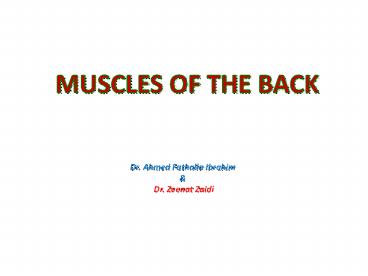MUSCLES OF THE BACK - PowerPoint PPT Presentation
Title:
MUSCLES OF THE BACK
Description:
Dr. Ahmed Fathalla Ibrahim & Dr. Zeenat Zaidi OBJECTIVES At the end of the lecture, students should be able to: Distinguish between the different groups of back muscles. – PowerPoint PPT presentation
Number of Views:168
Avg rating:3.0/5.0
Title: MUSCLES OF THE BACK
1
MUSCLES OF THE BACK
Dr. Ahmed Fathalla Ibrahim Dr. Zeenat Zaidi
2
OBJECTIVES
- At the end of the lecture, students should be
able to - Distinguish between the different groups of back
muscles. - Compare between groups of back muscles as regard
their nerve supply and action. - List the back muscles of each group.
- Describe the attachments of each muscle of the
superficial group, as well as, its nerve supply
and action. - Describe the triangles of back and their clinical
significance.
3
BACK MUSCLES
The muscles of the back are divided into two main
groups
- Intrinsic muscles
- Develop in the back
- Supplied by posterior rami of spinal nerves
- Extrinsic muscles
- Not developed in the back
- Supplied by anterior rami of spinal nerves.
4
DEEP GROUP OF BACK MUSCLES
- They extend from sacrum to skull.
- They include extensors and rotators of head
vertebral column. - Their tone is responsible for maintenance of
normal curvature of vertebral column. - The largest muscle of this group is erector
spinae which is formed of 3 vertical columns
(from lateral to medial iliocostalis,
longissimus spinalis).
(Note the length and attachment of the muscle
fibers)
5
INTERMEDIATE GROUP OF BACK MUSCLES
- It is separated from the deep group by
thoracolumbar fascia. - It includes
- Serratus posterior superior (rib elevator).
- Serratus posterior inferior (rib depressor).
- Nerve supply anterior rami of thoracic spinal
nerves.
6
SUPRERFICIAL GROUP OF BACK MUSCLES
- Includes two sets of muscles
- Muscles connecting vertebral column to scapula
(move scapula through shoulder girdle joints)
include - Trapezius.
- Levator scapulae.
- Rhomboid minor.
- Rhomboid major.
- Muscle connecting vertebral column to humerus
(move humerus through shoulder joint), include - Latissimus dorsi.
2
1
3
4
7
TRAPEZIUS
- Origin Spines of cervical thoracic vertebrae
- Insertion lateral 1/3 of clavicle acromion
spine of scapula. - Action rotation of scapula during abduction of
humerus above horizontal. - Upper fibers elevate scapula.
- Middle fibers retract scapula
- Lower fibers depress scapula.
- Nerve supply Spinal part of accessory (11th
cranial) nerve.
Insertion
Action
Origin
8
LEVATOR SCAPULAERHOMBOID MINOR MAJOR
- Origin
- Levator scapulae cervical transverse processes
- Rhomboid minor major thoracic spines
- Insertion medial border of scapula.
- Nerve supply dorsal scapular nerve.
- Actions
- Levator scapulae elevates scapula.
- Rhomboid minor major retract scapula.
Insertion
9
LATISSIMUS DORSI
- Origin spines of thoracic vertebrae.
- Insertion bicipital groove of humerus.
- Nerve supply thoracodorsal nerve.
- Actions extension, adduction medial rotation
of humerus (arm, shoulder joint).
Insertion
Origin
10
MUSCULAR TRIANGLES OF BACK
- Auscultatory Triangle
- Boundaries latissimus dorsi, trapezius, and
medial border of scapula. - Site where breath sounds are most easily heard
with a stethoscope. - Lumbar Triangle (Triangle of Petit)
- Boundaries latissimus dorsi, posterior border
of external oblique muscle of the abdomen, and
iliac crest. - Site of an abdominal hernia or where pus may
emerge from the abdominal wall.
11
SUMMARY
- BACK MUSCLES
- Deep group attached to moves vertebral column,
supplied by posterior rami of spinal nerves. - Intermediate group attached to moves ribs,
supplied by anterior rami of spinal nerves. - Superficial group
- - Origin vertebral column.
- - Insertion scapula (EXCEPT latissimus dorsi
humerus). - - Action moves scapula (EXCEPT latissimus
dorsi moves humerus). - - Nerve supply anterior rami of spinal nerves
through brachial plexus (EXCEPT trapezius 11th
cranial nerve).
12
QUESTION 1
- Which one of the following muscles of back that
rotates the humerus medially ? - Trapezius.
- Latissimus dorsi.
- Rhomboid major.
- Serratus posterior superior.
13
QUESTION 2
- Regarding back muscles, which one of the
following statements is correct? - All back muscles are supplied by posterior rami
of spinal nerves. - Muscles of intermediate group move vertebral
column. - Muscles of superficial group are involved in
upper limb movements. - Muscles of deep group serve respiratory
functions.
14
THANK YOU

